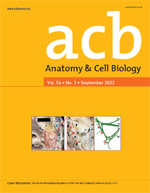학술논문
Cell clusters in intervertebral disc degeneration: an attempted repair mechanism aborted via apoptosis
이용수 0
- 영문명
- Cell clusters in intervertebral disc degeneration: an attempted repair mechanism aborted via apoptosis
- 발행기관
- 대한해부학회
- 저자명
- Polly Lama Jerina Tiwari Pulkit Mutreja Sukirti Chauhan Ian J Harding Trish Dolan Michael A Adams
- 간행물 정보
- 『Anatomy and Cell Biology』Vol.56(3), 382~393쪽, 전체 12쪽
- 주제분류
- 의약학 > 의학일반
- 파일형태
- 발행일자
- 2023.09.30

국문 초록
영문 초록
Cell clusters are a histological hallmark feature of intervertebral disc degeneration. Clusters arise from cellproliferation, are associated with replicative senescence, and remain metabolically, but their precise role in various stages of disc degeneration remain obscure. The aim of this study was therefore to investigate small, medium, and large size cell-clusters. For this purpose, human disc samples were collected from 55 subjects, aged 37-72 years, 21 patients had disc herniation, 10 had degenerated non-herniated discs, and 9 had degenerative scoliosis with spinal curvature <45°. 15 non-degenerated control discs were from cadavers. Clusters and matrix changes were investigated with histology, immunohistochemistry, and Sodium dodecyl sulphate polyacrylamide gel electrophoresis (SDS-PAGE). Data obtained were analyzed with spearman rank correlation and ANOVA. Results revealed, small and medium-sized clusters were positive for cell proliferation markers Ki-67 and proliferating cell nuclear antigen (PCNA) in control and slightly degenerated human discs, while large cell clusters were typically more abundant in severely degenerated and herniated discs. Large clustersassociated with matrix fissures, proteoglycan loss, matrix metalloproteinase-1 (MMP-1), and Caspase-3. Spatial associationfindings were reconfirmed with SDS-PAGE that showed presence to these target markers based on its molecular weight. Controls, slightly degenerated discs showed smaller clusters, less proteoglycan loss, MMP-1, and Caspase-3. In conclusion, cell clusters in the early stages of degeneration could be indicative of repair, however sustained loading increases large cell clusters especially around microscopic fissures that accelerates inflammatory catabolism and alters cellular metabolism, thus attempted repair process initiated by cell clusters fails and is aborted at least in part via apoptosis.
목차
Introduction
Materials and Methods
Results
Discussion
ORCID
Author Contributions
Conflicts of Interest
Funding
References
해당간행물 수록 논문
참고문헌
최근 이용한 논문
교보eBook 첫 방문을 환영 합니다!

신규가입 혜택 지급이 완료 되었습니다.
바로 사용 가능한 교보e캐시 1,000원 (유효기간 7일)
지금 바로 교보eBook의 다양한 콘텐츠를 이용해 보세요!




